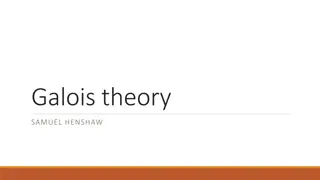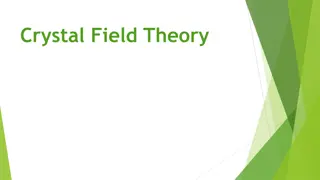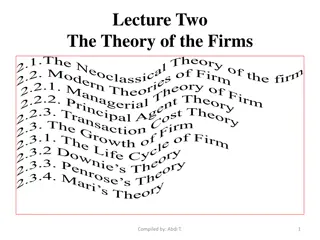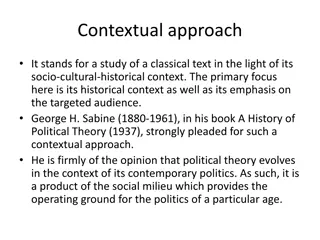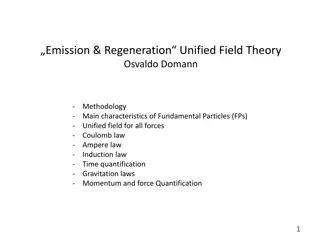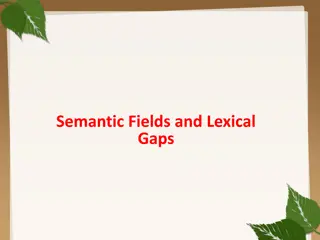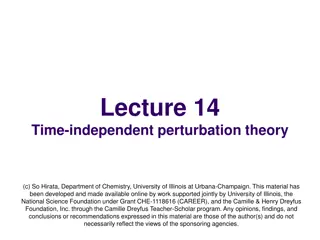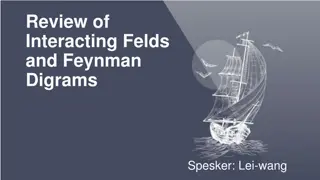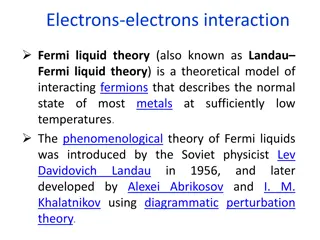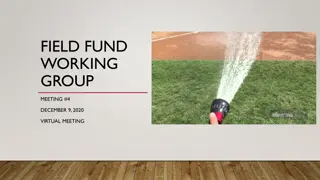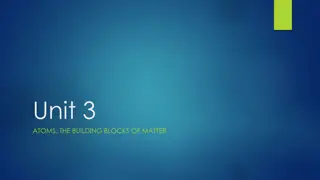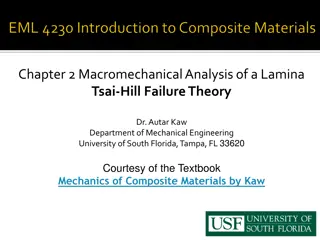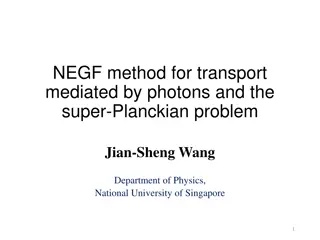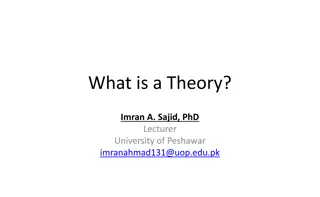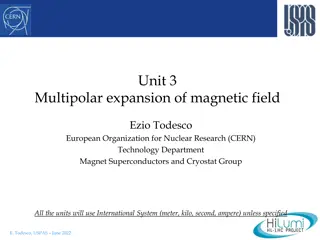Crystal Field Theory in Transition Metal Complexes
Crystal Field Theory (CFT) explains the colors and magnetic properties of transition metal complexes. It focuses on the energy changes in d-orbitals of metal ions caused by surrounding ligands. This theory, developed in 1929, provides insights into the bonding interactions in complex compounds. The
14 views • 44 slides
Evolution of Mathematical Theories and Proof Systems
Development of mathematical theories such as model theory, proof theory, set theory, recursion theory, and computational complexity is discussed, starting from historical perspectives with Dedekind and Peano to Godel's theorems, recursion theory's golden age in the 1930s, and advancements in proof t
4 views • 29 slides
Galois Theory and Field Extensions
Explore the fundamental concepts of Galois theory, field automorphisms, prime subfields, and field extensions. Learn how symmetries and polynomials play a crucial role in creating new mathematical objects, and understand the significance of field extensions in adjoining roots of polynomials. Delve i
11 views • 14 slides
Psychological Theories of Criminality: Understanding the Roots
Psychological theories of criminality delve into the association between intelligence, personality, learning, and criminal behavior. Major theories include Psychodynamic Theory by Freud, Behavioral Theory by Bandura, and Cognitive Theory by Kohlberg. These theories explore how unconscious mental pro
12 views • 20 slides
Crystal Field Theory in Chemistry
Crystal Field Theory (CFT) explains how electron orbital degeneracies, particularly d or f orbitals, are affected by a static electric field generated by neighboring anions. In CFT, the metal ion is considered positive while ligands are negative charges, leading to attractive and repulsive forces af
4 views • 13 slides
Theory of Firms: Neoclassical vs. Modern Approaches
The theory of firms is explored through the Neoclassical and Modern perspectives. Neoclassical theory focuses on profit maximization, while Modern theory delves into managerial, principal-agent, and transaction cost theories. The discussion covers criticisms of Neoclassical theory and the essential
26 views • 79 slides
Electric Field Lines and Charges
Electric field lines provide a visual representation of the electric field around charges. They show the direction of the electric field and help understand the intensity of the field at different points. Field lines never cross each other and the tangent at any point on a line gives the field direc
6 views • 40 slides
Theories of Causation in Psychological and Social Sciences
Overview of theories of causation categorized into psychological, social psychological, and sociological perspectives. Psychological theories focus on instinctive, biological, and psychological qualities of abusers, including Attachment Theory, Psychodynamic Theory, Social Learning Theory, and Situa
5 views • 15 slides
Political Theory through a Contextual Approach
Exploring G.H. Sabine's perspective on political theory through a contextual approach, emphasizing the importance of historical context and societal influences. Sabine argues that while political theory evolves with its contemporary politics, it should be analyzed within its specific time and social
30 views • 9 slides
Unified Field Theory of Fundamental Particles by Osvaldo Domann
Methodology, characteristics, and interactions of Fundamental Particles (FPs) in the Unified Field Theory proposed by Osvaldo Domann are explored. The theory covers the unified field for all forces, quantum laws, momentum quantification, and more. It introduces the concept of Fundamental Particles m
3 views • 21 slides
Evolution of Light Theory: From Wave Theory to Quantum Theory
At the turn of the century, the discovery of the photoelectric effect challenged the wave theory of light, leading to the development of the quantum theory by Max Planck and Albert Einstein. This new theory introduced the concept of discrete energy units known as quanta, bridging the gap between wav
8 views • 62 slides
Evolution of Semantic Field Theory in Linguistics
The theory of semantic fields, also known as field-theory, originated in the 1920s and 1930s with German and Swiss scholars. J. Trier and L. Weisgerber further developed this theory post World War II, associating it with the Language and Society movement. Trier's approach focused on comparing the st
7 views • 20 slides
Dp-branes, NS5-branes, U-duality, and M-Theory Overview
Overview of Dp-branes, NS5-branes, and U-duality derived from nonabelian (2,0) theory with Lie 3-algebra. Introduction to M-theory, including M2-branes and M5-branes in the strong coupling limit. Discussion on BLG theory, Lorentzian Lie 3-algebra, and the ABJM theory for M2-branes.
4 views • 32 slides
Time-Independent Perturbation Theory in Quantum Mechanics
Perturbation theory is a powerful tool in solving complex physical and mathematical problems approximately by adjusting solutions from a related problem with known solutions. This theory allows for more accurate approximate solutions by treating the difference as a small perturbation. An example inv
5 views • 19 slides
Interacting Fields and Feynman Diagrams in Quantum Field Theory
Delve into the fascinating world of quantum field theory with a focus on interacting fields and Feynman diagrams. Explore perturbation theory, correlation functions, Wick's theorem, and Feynman diagram rules to gain insights into preserving causality, calculating two-point correlation functions, and
5 views • 18 slides
Ethical Theories: Divine Command vs. Virtue Theory Explained
Divine Command Theory asserts that morality is derived from God's commands, contrasting with Virtue Theory which focuses on developing moral virtues to achieve human flourishing and excellence. Divine Command Theory relies on religious texts, while Virtue Theory emphasizes the cultivation of virtues
1 views • 24 slides
Fermi Liquid Theory in Interacting Fermion Systems
Fermi liquid theory, also known as Landau-Fermi liquid theory, is a theoretical model that describes the normal state of metals at low temperatures. Introduced by Landau and further developed by Abrikosov and Khalatnikov, this theory explains the similarities and differences between interacting ferm
3 views • 23 slides
Field Fund Working Group Meeting Insights and Analysis
The Field Fund Working Group Meeting #4 held on December 9, 2020, virtually discussed various topics related to field fund allocations, fee considerations, and capital improvement plans. The meeting covered important aspects such as benchmarking, investment in capital projects, recurring field maint
3 views • 38 slides
Computational Learning Theory: An Overview
Computational Learning Theory explores inductive learning algorithms that generate hypotheses from training sets, emphasizing the uncertainty of generalization. The theory introduces probabilities to measure correctness and certainty, addressing challenges in learning hidden concepts. Through exampl
3 views • 43 slides
Automata Theory and Theory of Computation Overview
This course overview covers concepts in automata theory and theory of computation, including formal language classes, grammars, recognizers, theorems in automata theory, decidability, and intractability of computational problems. The Chomsky hierarchy, interplay between computing components, modern-
15 views • 42 slides
Theories of Interest in Microeconomics II
Explore various theories of interest in economics, including the Classical Theory, Liquidity Preference Theory by Keynes, Productivity Theory, Abstinence Theory, Time-Preference Theory, Fisher's Time Preference Theory, and the Loanable Fund Theory. These theories offer different perspectives on the
3 views • 6 slides
The Evolution of Atomic Theory
Delve into the historical journey of atomic theory starting from Democritus and Aristotle's views to modern advancements proving some aspects of Dalton's theory incorrect. Learn about key laws and theories such as the Particle Theory of Matter, Dalton's Atomic Theory, and JJ Thomson's discoveries, s
4 views • 30 slides
Macromechanical Analysis of Lamina and Tsai-Hill Failure Theory Overview
The Tsai-Hill failure theory is based on the strengths of a unidirectional lamina, incorporating longitudinal and transverse tensile and compressive strengths, as well as in-plane shear strength. This theory, derived from the distortion energy theory, provides criteria for determining lamina failure
2 views • 15 slides
Advanced Methods in Transport Phenomena and Quantum Field Theory
Explore cutting-edge research in transport processes mediated by photons, tight-binding models for electron behavior, electron-field interactions, NEGF definitions, fluctuation-dissipation theorem, Dyson equations, and Keldysh equations in the context of quantum field theory and super-Planckian near
0 views • 18 slides
Theories of Personality: Type Theory, Trait Theory, Psychoanalytic Theory
Personality theories such as Type Theory, Trait Theory, and Psychoanalytic Theory classify personality based on various factors like body build, introversion/extroversion, enduring characteristics, and unconscious forces influencing behavior.
5 views • 13 slides
Theory: Nets to Rationalize, Explain, Master
The concept of theory is explored through the works of Imran A. Sajid, Ph.D., and definitions by various scholars. Essential elements of a theory, including concepts, facts, hypotheses, and principles, are dissected along with the role of concepts in theory-building, particularly in social work prac
2 views • 47 slides
Multipolar Expansion of Magnetic Field and Field Harmonics in Physics
This content delves into the concepts of field harmonics, Maxwell equations for magnetic field, complex numbers, and analytic functions in the context of magnetic field measurements. It explores the mathematical intricacies involved in understanding magnetic fields and the applications of these theo
2 views • 46 slides
Overview of Davis Field Plan for Park & Recreation Commission
This presentation outlines the development process of the Davis Field Plan by the Park & Recreation Commission. It includes reasons for engagement, methodology used for athletic field assessment, field inventory details, evaluation of existing fields, and the demand for field usage. Through images a
4 views • 13 slides
On-Shell Methods in Quantum Field Theory
Delve into the intriguing realm of on-shell methods in quantum field theory through a comprehensive exploration of techniques like BCFW recursion relations, unitarity principles, Feynman integrals, and more. Uncover the intricacies of calculating tree amplitudes, handling diagram-by-diagram challeng
3 views • 53 slides
Magnetic Field Lines and Flux
Magnetic field lines provide a visual representation of the direction of the magnetic field, similar to electric field lines. They help visualize the magnetic field's strength and direction. Cutting a permanent magnet in half results in two dipoles. Magnetic flux, a scalar quantity, is defined over
2 views • 11 slides
Theory Construction in the Social Sciences: Understanding Components and Types
Explore the key components of theory construction in the social sciences, including the definition of theory, different types of theories, components of a theory, and the distinction between Big T and small t theories. Discover what theory is not and gain insights into the process of theory construc
3 views • 38 slides
Holographic Interface and Collaboration in Theoretical Physics
Dive into the fascinating world of theoretical physics with a focus on holographic interfaces, collaborations, main achievements in gauge theory and gravity calculations, along with explorations of quantum field theory, AdS/CFT correspondence, and more. Discover the intricate interplay between holog
0 views • 43 slides
Theory, Technology, and Education: Reflections and Challenges
Delve into the complex interplay between theory, technology, and education as discussed in a engaging seminar. Explore the nuances of theorising in social science, the significance of theory in understanding social phenomena, dimensions of theory, practical applications, and the inherent difficultie
1 views • 17 slides
Valence Bond Theory vs Molecular Orbital Theory: A Comparison
Explore the differences between Valence Bond Theory and Molecular Orbital Theory, including their postulates, strengths, and weaknesses. Valence Bond Theory, proposed by Linus Pauling, focuses on atomic orbital overlap, while Molecular Orbital Theory, introduced by Hund and Mullikan, emphasizes the
31 views • 16 slides
Crystal Field Theory in Octahedral Complexes: Factors and Stabilization Energy
Explore the principles of Crystal Field Theory in octahedral complexes, including the influence of ligands, metal ions, and oxidation states on crystal field splitting energy. Learn about the factors affecting Crystal Field Stabilization Energy in high and low spin configurations.
3 views • 9 slides
Exploring M-Theory and Matrix Models for String Theory Enthusiasts
Delve into the intriguing world of M-Theory and Matrix Models with discussions on the different aspects including M-Theory's purpose, the Moduli Space of String Theory, Consistent String Theories, and the significance of D-branes in String Theory. Explore the mysteries and recent developments surrou
17 views • 45 slides
Leadership Theories: Trait Theory vs. Behavioural Theory
Explore the evolution of leadership theories, focusing on Trait Theory and Behavioural Theory. Trait Theory emphasizes specific traits of great leaders, while Behavioural Theory shifts focus to actions and behaviors. Learn about the strengths and weaknesses of Trait Theory in identifying universal l
1 views • 8 slides
Understanding Crystal Field Theory in Chemistry
Crystal Field Theory (CFT) explains how electron orbital states in d or f orbitals are affected by surrounding charge distributions. It describes the breaking of degeneracies due to static electric fields, leading to the splitting of d orbitals and the formation of different energy sets in octahedra
4 views • 13 slides
Understanding Univalent Functions and Type Theory
Exploring the connection between univalent functions, homotopy theory, and type theory with a focus on Vladimir Voevodsky's program to express mathematics in type theory. Learn about the significance of homotopy theory in algebraic topology and the shift from set theory to type theory in mathematica
4 views • 22 slides
Grid Pix Field Simulations & Precision Study
Dive into the world of grid pixel field simulations and precision requirements for a module designed by Peter Kluit and Jan Timmermans. This simulation project focuses on studying edge effects and E-field deformations, using analytic expressions for field calculations. Explore the impact of grid des
0 views • 15 slides


